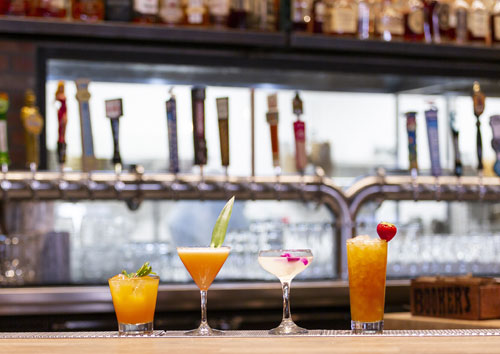 Cocktails on tap enables bartenders to serve drinks more consistently and efficiently improving profits.
Cocktails on tap enables bartenders to serve drinks more consistently and efficiently improving profits.
Why put Cocktails on Tap?
To satisfy today’s consumer expectation for variety and choice, it’s critical to have a diverse beverage program. According to Draftline Technologies, the industry beer line management leader, as of November 2021, the number of restaurants and bars with open draft lines has increased to 47 percent. The space on tap, coupled with consumer shift away from beer and towards spirits, creates an opportunity to place alternative beverages on tap – most notably cocktails.
Due to many liquor restrictions, the easiest way to execute cocktails on tap is through a pre-batched kegged cocktail. This platform enables bartenders to serve drinks more consistently and in less time. Instead of multiple bartenders making hundreds of drinks, one bartender/manager is responsible for making a batch that can equal hundreds of drinks. When done correctly, each drink will be the same. The opportunity for efficiency and consistency is more important than ever, with current labor shortages and high turnover. When there are improvements to volume, speed of service, and quality, bottom line profits are sure to improve as well.
Why is it important to choose the right cocktail on tap equipment?
Whether you're designing a new system or converting existing beer taps to cocktail stations, you'll want to use the right equipment to provide a great beverage experience that will keep customers coming back: use only 304-grade stainless equipment and components, high-grade Barriermaster beverage tubing, and a quality mixing system to ensure beverage consistency.
How does hardware material affect a cocktail’s quality?
Depending on the type of material used, it will affect the taste. When designing your system, never use inferior plated brass or lower grade 303-grade stainless steel components as the beverages you serve can develop a metallic taste or unwanted smell. To prevent this, all metal components, from keg to glass, should consist of 304-grade stainless steel, since it’s corrosion resistant and designed to prevent reaction with the product being dispensed.
How can you choose beverage lines for optimal taste?
The tubing in your draft system can have a significant impact on the flavor of the beverages you serve. Because of the high permeation rates of the vinyl or polyethylene tubing (commonly used in beer systems), beverages such as cocktails, wine, and cold brew, can become oxidized due to air ingress through tubing, or if the product is carbonated, it can acquire inconsistency as the carbonation leaves the tubing. Instead, use Barriermaster Flavourlock beverage tubing, which has one of the lowest permeation rates of any beverage line in the industry and allows products to be changed out seamlessly without off-flavors or off-tastes.
How can you ensure beverage consistency?
 SpinStick™ technology ensures the continuous blending of pre-mixed cocktails and prevents recipes from separating or settling.
SpinStick™ technology ensures the continuous blending of pre-mixed cocktails and prevents recipes from separating or settling.
With the complexity of ingredients used in today’s cocktails, you’ll want to make sure that your beverages are served consistently. If your cocktail requires continuous mixing, you can utilize SpinStick — our patent pending technology that prevents recipes from separating or settling. Drop the SpinStick stirrer into a 9L or 18L re-usable Beverage Tank with a batch recipe of your choice, place the tank on top of the proprietary motor base and within moments, a gentle vortex will form, constantly stirring your cocktail.
Which gas should be used for cocktails?
When beverages are meant to be still, the gas applied to the beverage tank should be food-grade nitrogen. On the other hand, carbonated cocktails in a short direct draw system such as a kegerator require 100% CO2 at an amount that will preserve the right amount of effervescence for the entire batch. Typically, for beer’s carbonation levels, this would be between 12-15 lbs. Adjust CO2 as necessary for the perfect carbonation. In remote or long draw systems, a blended mix of CO2 and nitrogen may be necessary.
Additional tips to ensure the quality of on tap cocktails:
- If you’re keeping cocktail tanks alongside beer kegs, rest assured that the same temperature is ideal for them. If you’re serving a drink that requires a different temperature, you can also usedual temperature zone kegerators.
- Maintain your equipment regularly. Clean product lines and other accessible components every two weeks.
- While mixologists love to innovate, cocktail batches made with pulp should be strained twice prior to placing in the keg as they can clog the system.
By implementing these practices, you’ll be able to serve high-quality cocktails that keep patrons coming back for more.
For more information on setting up a cocktail on tap system, contact Micro Matic at This email address is being protected from spambots. You need JavaScript enabled to view it. and download this brochure.
Content Sponsored by Micro Matic.



